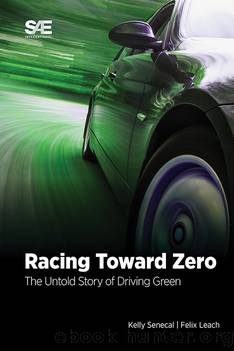Racing Toward Zero by Kelly Senecal;Felix Leach;

Author:Kelly Senecal;Felix Leach;
Format: epub
Publisher: SAE International
FIGURE 9.5 GDI engine market share in the USA from 2008 to 2017 [16].
So why all this fuss over how the fuel is delivered? In short, fuel economy! Injecting fuel directly in the cylinder allows for more precise control of fuel quantities. In addition, as the fuel evaporates, it cools the cylinder mixture, increasing its density (and hence efficiency) and reducing the chance of knocking.
We briefly introduced the concept of engine knock back in Chapter 3, but to refresh our memories, knock occurs when a pocket of air-fuel mixture ignites ahead of the flame front in an SI engine. This leads to pressure waves that can damage engine parts and produce a âknockingâ noise. Knock effectively limits the compression ratio in todayâs gasoline engines, which in turn limits their efficiency. Much of todayâs engine research is dedicated to improving the efficiency of engines while avoiding knock. Fuels with high octane numbers (either research octane number, RON, or motor octane number, MON) can also help mitigate knock.4 Another unwelcome type of autoignition is low speed pre-ignition (LSPI)âalso known as megaknock or superknockâwhich is an unanticipated consequence of downsized, boosted engines. LSPI is believed to occur from the interaction of fuel and lubricating oil droplets, and it can cause severe engine damage.
All of this together means that GDI offers gains in efficiency compared to other fuel delivery methods through increased compression ratios and evaporative cooling. Regardless of how the fuel is delivered, though, remember that we start out with liquid fuel at the pump. Does liquid fuel burn? Perhaps youâve ordered a flaming cocktail at your favorite bar (please donât try this at homeâleave it to a professional bartender!). As long as the alcohol content is high enough, the drink will burn. But the liquid itself isnât burningâitâs the alcohol vapors just above the liquid surface, initially created by the heat of the lighter, that burn.
Gasoline in your engine behaves the same way. The fuel has to evaporate and mix with air before combustion can occur. But remember, in an engine this has to happen in just milliseconds. To speed up the process, we rely on hotness and surface area. The compression stroke in Figure 9.1 gives us the hotness, but how do we increase the surface area? We do this by breaking up the liquid fuel into tiny drops. And by tiny we mean tinyâthey can be as small as 10 μm or less. How this breakup is accomplished is largely a function of the fuel delivery approach. For example, in PFI engines, liquid breakup occurs both through the interaction with the surrounding air and with the hot intake valve surfaces.
Itâs beyond the scope of this book to go into the details of liquid spray breakup and evaporation (although this is one of Kellyâs favorite topics), so please trust us that it happens fast enough (mostly!) to form an appropriate air-fuel mixture for combustion.
Download
This site does not store any files on its server. We only index and link to content provided by other sites. Please contact the content providers to delete copyright contents if any and email us, we'll remove relevant links or contents immediately.
| Automotive | Engineering |
| Transportation |
Machine Learning at Scale with H2O by Gregory Keys | David Whiting(3604)
Never by Ken Follett(3516)
Urban Outlaw by Magnus Walker(3236)
OPNsense Beginner to Professional by Julio Cesar Bueno de Camargo(3191)
Sapiens and Homo Deus by Yuval Noah Harari(2839)
Will by Will Smith(2572)
A Short History of Nearly Everything by Bryson Bill(2503)
Hooked: A Dark, Contemporary Romance (Never After Series) by Emily McIntire(2410)
Rationality by Steven Pinker(2146)
Borders by unknow(2115)
Holy Bible (NIV) by Zondervan(2022)
The Becoming by Nora Roberts(1913)
The One Percenter Encyclopedia by Bill Hayes(1713)
Freedom by Sonny Barger(1712)
HBR's 10 Must Reads 2022 by Harvard Business Review(1693)
A Short History of War by Jeremy Black(1665)
Five Ways to Fall by K.A. Tucker(1630)
Girls Auto Clinic Glove Box Guide by Patrice Banks(1615)
Go Tell the Bees That I Am Gone by Diana Gabaldon(1594)
